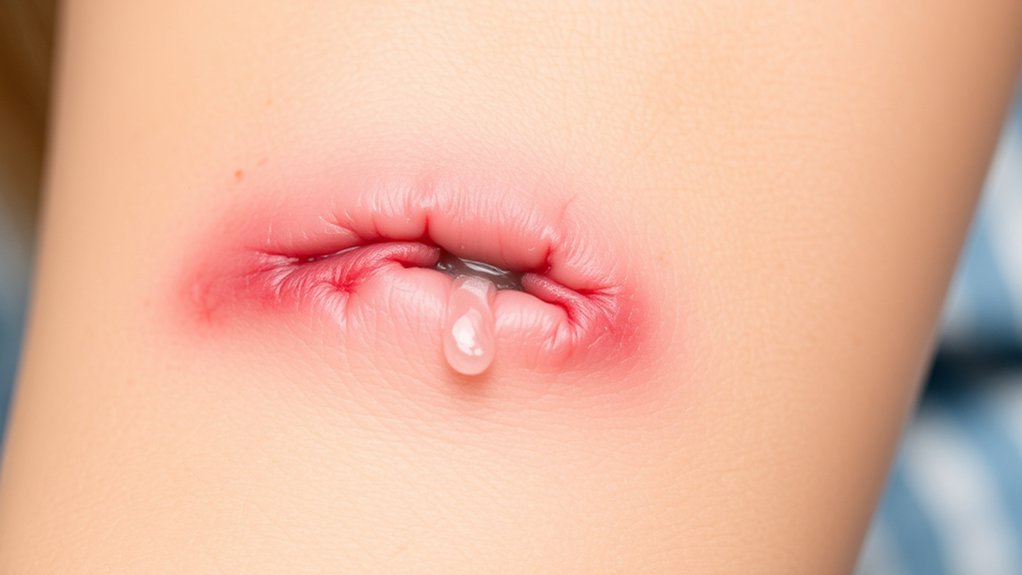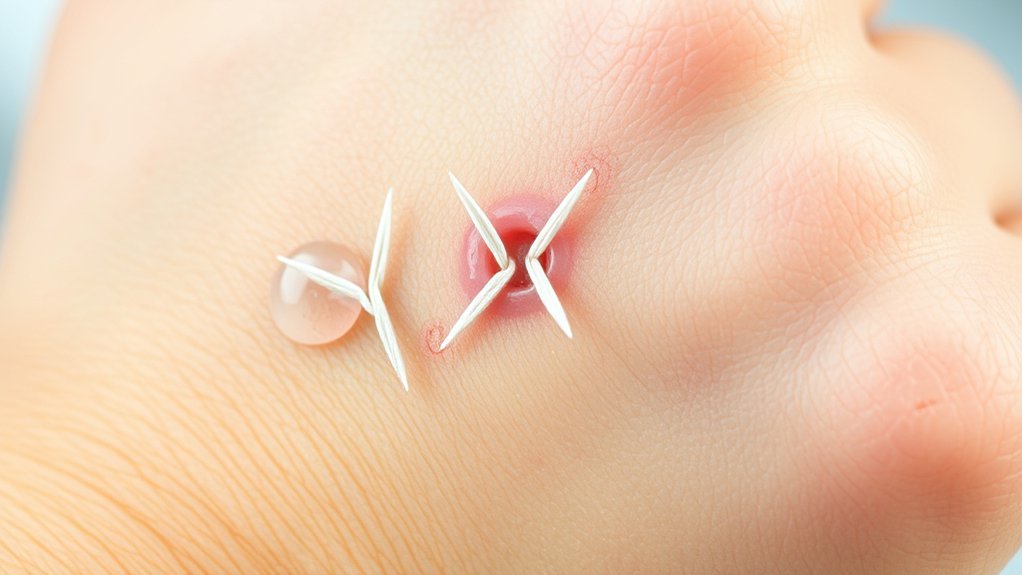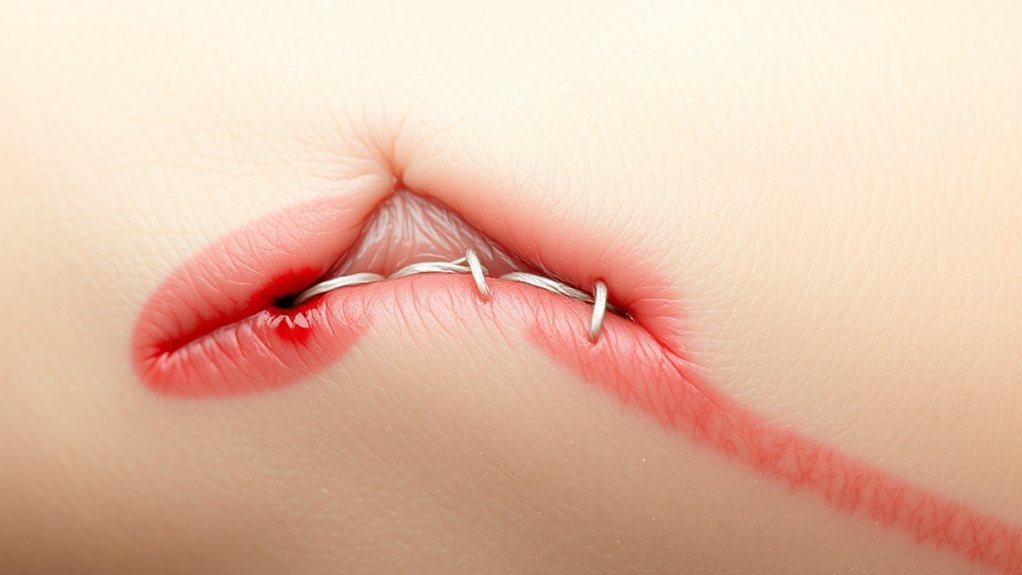When you have stitches, understanding their care is essential for a smooth recovery. Monitoring for signs of healing, like scab formation and reduced swelling, is important. However, you also need to watch for symptoms of infection, such as unusual drainage and increased pain. Knowing how to distinguish between these signs can make a significant difference in your healing process. So, what should you do if you notice any concerning symptoms?
Understanding Stitches and Their Purpose
Stitches, or sutures, play a significant role in wound care by closing injuries and promoting healing.
These sterile threads, made from various materials, are important for wounds deeper than a quarter of an inch or those exposing fat, muscle, or bone. Cuts near sensitive areas like the eyes and mouth often require stitches to guarantee proper healing.
A healthcare professional carefully places stitches to align wound edges, which is essential in minimizing scarring and reducing the risk of infection. Understanding when stitches are necessary empowers you to seek timely medical treatment, facilitating effective wound management.
Choosing between absorbable and non-absorbable stitches further impacts the healing process, making knowledge about stitches crucial for ideal recovery.
Common Signs of Healing
As your wound begins to heal, you’ll notice several key signs indicating progress. Scab formation is one of the first signs of wound healing, providing a protective barrier.
As your wound heals, watch for scab formation, reduced redness, and the emergence of new tissue as key progress indicators.
You’ll likely observe a reduction in redness and swelling around the stitches as the inflammatory response subsides. The presence of granulation tissue, which appears pink or red and may feel bumpy, signifies new tissue formation.
As healing continues, the stitches may become less visible, and you should experience decreased pain and tenderness. Additionally, improvements in the wound’s appearance, such as a gradual reduction in scar size and increased skin elasticity, are positive signs.
Throughout this process, the absence of infection, such as pus or increased pain, is essential for effective healing.
Symptoms Indicating Infection
When caring for your stitches, watch for signs of infection that could complicate healing.
Symptoms like yellow or green drainage, redness, increased pain, or a foul smell indicate potential issues that require immediate attention.
Recognizing these warning signs early can help you seek the proper care and prevent further complications.
Common Infection Indicators
How can you tell if a stitched wound is becoming infected? Watch for these common infection indicators:
- Pus Coming: Yellow or green drainage from the wound site indicates the presence of bacteria.
- Redness: Increased redness or discoloration around the stitches signifies an inflammatory response, often linked to infection.
- Swelling: Look for swelling, warmth, or heightened pain near the stitches; these symptoms may suggest an infection is developing.
- Fever: Accompanying symptoms like fever can indicate a systemic response to infection, which requires urgent medical attention.
If you notice any of these signs, it’s essential to consult a healthcare professional promptly to prevent further complications.
Risk Factors Overview
Understanding the risk factors that can lead to infection in stitched wounds is essential for effective care.
Signs that your wound may be infected include yellow or green drainage, indicating bacterial activity. Redness and discoloration around the stitches often suggest inflammation, which can signal an infection.
You should also watch for swelling, warmth, and pain near the stitches; tenderness may increase upon touch. A foul smell from the area, along with fever, indicates your body’s response to infection.
Persistent pain or increased bleeding from the wound are critical warning signs that require immediate medical evaluation. Recognizing these symptoms early can help prevent complications and guarantee proper care for your stitched wound.
What to Do If You Suspect Infection
If you suspect an infection in your stitches, recognize symptoms like redness, swelling, or pus.
Clean the area gently with mild soap and water, and avoid applying any creams unless prescribed.
It’s crucial to seek medical attention promptly, especially if you experience persistent pain or fever.
Recognize Infection Symptoms
When detecting infection symptoms at the stitch site, you should be vigilant for signs like increased redness, swelling, warmth, and any yellow or green pus. It’s important to recognize symptoms early to prevent complications.
Additionally, monitor for additional signs such as:
- Persistent pain around the stitch area
- A foul smell emanating from the wound
- Fever or chills
- Worsening symptoms over time
If you notice any signs of infection, gently clean the wound with mild soap and water.
Don’t hesitate to seek medical attention if symptoms worsen or don’t improve within a few days. Regular follow-ups with your healthcare provider are essential for proper healing and to address any complications that may arise.
Immediate Cleaning Steps
Suspecting an infection in your stitches requires immediate action to reduce the risk of complications.
First, wash the area gently with mild soap and warm water to clean away debris and bacteria. After cleaning, pat the area dry with a clean towel—don’t rub or irritate the stitches.
If recommended by your healthcare provider, apply a thin layer of antibiotic ointment to help prevent infection.
It’s vital to monitor the wound closely for signs of infection, such as increased redness, swelling, pus, or fever. Document any changes, as this information can help your healthcare provider assess the situation.
Seek Medical Attention
Noticing unusual symptoms around your stitches can be alarming, and it’s essential to act quickly.
If you suspect an infected wound, here are signs that you should consult a healthcare provider:
- Increased pain: If the pain worsens instead of improving.
- Redness and swelling: Persistent redness or swelling around the stitches.
- Drainage from the wound: Yellow or green drainage or pus, which indicates infection.
- Foul smell and fever: A bad odor from the area, accompanied by fever, signals a serious infection.
Early intervention is vital to prevent complications, such as tissue damage or systemic infections.
Don’t hesitate to seek medical attention if you notice any of these symptoms. Your health is paramount.
When to Seek Medical Attention

How can you tell if your stitches need medical attention? If bleeding from the wound persists after applying pressure for 15 minutes, it’s essential to seek medical attention, as this may indicate a deeper injury.
Look for signs of infection around the stitches, such as increased redness, swelling, pus, or a foul smell; contact a healthcare provider if these occur.
Monitor your stitches for infection: redness, swelling, pus, or a foul odor require immediate contact with a healthcare provider.
Severe pain that worsens over time or doesn’t improve with pain relief measures also warrants consultation with a medical professional.
Additionally, if your stitches feel tight or show signs of pulling apart, it could lead to reopening the wound.
Finally, developing a fever or chills signals a need for prompt medical care, as these may indicate a systemic infection.
Factors Influencing the Healing Process
Here are key elements to take into account:
- Proper Nutrition: Adequate protein, vitamins C and A, and minerals like zinc are essential for tissue repair and regeneration.
- Hydration: Maintaining hydration supports cell function and moisture balance, greatly enhancing healing efficiency.
- Chronic Health Conditions: Conditions like diabetes and obesity can delay healing and increase the risk of infection, requiring closer monitoring.
- Wound Care Practices: Effective cleaning and protection of the wound minimize complications and promote ideal healing.
Additionally, your immune system status and age can impact the speed and quality of recovery. Proper nutrition is critical for health and development, which can further influence your overall healing process.
The Importance of Proper Wound Care
Proper wound care is essential for minimizing infection risk and ensuring effective healing. You should regularly check for signs of infection, such as increased redness, swelling, or pus.
Keeping stitches clean and dry is vital; apply antibiotic ointment as directed to promote healing and minimize scarring. Change dressings according to your healthcare provider’s instructions, as this greatly impacts proper healing.
Monitor your wound for unusual discharge or any changes that may require immediate attention. Additionally, maintaining adequate nutrition, hydration, and rest supports your body’s healing processes.
Managing Pain and Discomfort

Managing pain and discomfort after getting stitches is essential for a smooth recovery. Here are some effective ways to manage your pain:
Managing pain after getting stitches is crucial for a smooth recovery. Here are effective strategies to ease your discomfort.
- Over-the-counter pain relievers: Use medications like acetaminophen or ibuprofen as directed by your healthcare provider to alleviate pain.
- Cold compress: Apply a cold compress to the wound for 15-20 minutes to reduce swelling and numb discomfort.
- Keep the area clean: Maintaining a clean and dry environment around your stitches prevents infection and promotes healing.
- Avoid irritation: Don’t touch or scratch the stitched area, as this can increase pain, irritation, and the risk of infection.
If your pain worsens markedly, consult your healthcare provider for further evaluation and treatment.
Long-term Care and Monitoring for Complications
While you focus on healing, it’s crucial to monitor the stitched area for any signs of complications. Regularly inspect for signs of infection, such as increased redness, swelling, pus drainage, or a foul smell. If you notice these symptoms, contact your healthcare provider immediately.
Maintain proper wound care by keeping the area clean and dry, following your provider’s instructions for dressing changes. Be vigilant for symptoms of systemic infection, like fever, chills, or increased pain, and seek medical attention if they arise.
Additionally, monitor for unusual changes in the scar’s appearance, such as excessive thickening or keloid formation. Don’t forget to schedule follow-up appointments to guarantee a smooth healing process and timely removal of non-dissolvable stitches.
Frequently Asked Questions
What Are the Signs That Stitches Are Healing?
You’ll notice stitches are healing when redness and swelling decrease, a scab forms, pain lessens, granulation tissue appears, and the scar gradually softens and fades. These signs indicate your body is repairing itself effectively.
How Do I Know if Something Is Wrong With My Stitches?
If your stitches resemble a wilting flower—red, swollen, or leaking—something’s wrong. Pay attention to worsening pain, foul odors, or fever. Gaps in the wound signal it’s time to consult a healthcare provider.
What Are Signs of Infection in Stitches?
You’ll notice signs of infection in stitches if there’s yellow or green drainage, increased redness, swelling, warmth, or pain. A foul smell and fever also indicate a severe infection needing immediate medical attention.
What Are the 5 Signs and Symptoms Associated With an Infected Wound?
If your wound’s looking like a horror movie, watch for increased redness, swelling, warmth, foul odor, and yellow or green drainage. Fever and chills can signal serious infection; seek medical help immediately if these arise.
Conclusion
To conclude, monitoring your stitches is essential for ensuring proper healing and preventing infection. Keep an eye out for positive signs like scab formation and reduced redness, while being vigilant for indicators of infection. If you notice any concerning symptoms, don’t hesitate to consult a healthcare provider. Remember, just as the ancients valued the art of healing, so too should you prioritize meticulous wound care to foster a swift and uneventful recovery.
